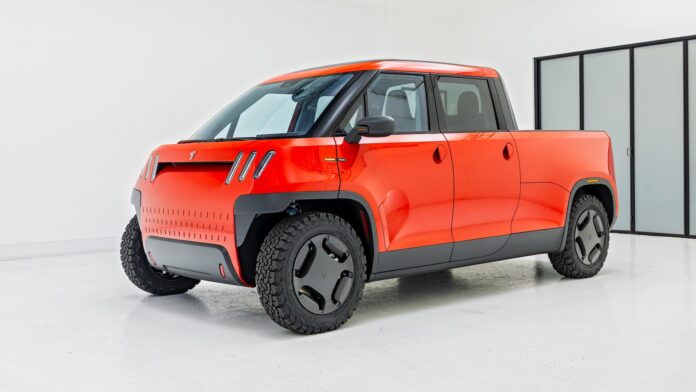Although the Telo MT1 electric minitruck is about as long overall as a two-door Mini Hardtop, it has five seats and a bed almost the same size as a crew-cab Toyota Tacoma’s standard-length bed. We met Telo back in 2023, when the MT1 wasn’t much more than a foam model with no interior or running gear. Since then, team Telo has been refining its concept and plotting a path to production. Now it has a driving prototype. We just took a ride, and it’s a truck quite unlike any we’re used to.
Wait—What’s Telo?
If you’re unfamiliar with Telo, say “hello”—that’s like how you pronounce the company’s name, not Tee-lo.
Cofounder and CEO Jason Marks has a background in engineering automotive active safety and autonomous driving systems. Cofounder and CTO Forrest North developed batteries at pre–Elon Musk Tesla before founding electric-centric companies like Mission Motors and PlugShare. We chatted with both of them back in November of 2024. Design lead Yves Béhar brings aesthetic and branding insights to the Telo project. Advisors and investors include Andy Palmer, past CEO of Aston Martin, Simon Sproule, who led communications for automakers including Tesla and Fiat Chrysler, and Martin Eberhard and Marc Tarpenning, the original founders of Tesla.
Telo cites its community as another vital source of guidance. It wants to be “the most open automaker,” CEO Marks said. “We want to take everyone on our journey with us, so we keep a very active Discord channel where you can talk to our team.” Members can even vote on design and functionality decisions in the development process.
This is the type of brainpower Telo needs if it wants to convince Americans to flip their understanding of what a truck should be: bigger, brawnier, and badassier than every other truck. No, Telo’s intent is to go small and be smart doing so.
How Small Is the Telo Truck? Very
“Every single one of our innovations is around space efficiency,” Marks said. Perhaps more than any other EV truck, the MT1 is shaped by the potential of electric powertrains. Not having an engine enables engineering flexibility to explore unconventional vehicle categories like this.
The MT1 goes extreme to maximize utility in minimum area. It’s 152 inches long overall on a 111-inch wheelbase, 73 inches wide, and 66 inches tall—with a five-seat cabin and 60-inch-long bed. The Ford Maverick, often derided as being too small, is about 200 inches long on a 121-inch wheelbase, 78 inches wide, and 69 inches tall, with a 54-inch bed. The Rivian R1T is relatively gargantuan, measuring 217 inches with a 136-inch wheelbase, 82 inches wide, and 73 inches tall in its lowest ride setting. Like the Maverick, the R1T’s bed is 54 inches long.
Looking beyond specs reveals details indicative of Telo’s packaging obsession. The tailgate is ultra-thin, and in the bed there’s as little wheelwell intrusion as in any truck we can recall. A folding partition between the bed and cab extends storage length to 8 feet with the tailgate closed. Instead of one cooling circuit requiring a large radiator, two circuits devoted to different systems allow for several smaller radiators to be dispersed around the truck. Telo borrows from the R1T with its underbed Monster Tunnel, named because it’s a monster under the bed—hey, not our idea. Unlike in the Rivian, though, it can be accessed from the bed, not only the sides. With how tall the MT1 is, it doesn’t seem so puny in person.
MT1 INTERIOR REVOLED
As Telo shows the MT1’s interior for the first time, a focus on optimizing space continues. A justified concern for anyone eyeing the MT1 is how five people could ever cram themselves in this little thing. Take it from your 6-foot-10 author, the MT1 is deceptively roomy. Once through the doors, I fit in both rows of seats, even with some headroom unless I sat bolt upright. Legroom, however, was lacking, especially in the second row. That said, there’s ample foot space beneath the front seats due to those being mounted on a single central post. Various pockets, hidden trays, a glass roof, and windows that lower fully into the doors contribute to actual and perceived spaciousness.
Exuberant interior materials contrast the minimalist exterior design. The cabin is awash in a geometric-patterned fabric, which reveals a subtle iridescence in person and looks much less headache-inducing than it does in photos. Elsewhere, formed cork trim and cast aluminum touchpoints add to a premium, sustainable impression. Stylish as it is, Telo would do well to offer an interior option with simple, hard-wearing materials for drivers who intend to put the MT1 to work.
Technology is typical for a new car. Dual dashboard displays measure approximately 13 inches, with the unit ahead of the driver covered by a perforated plate so it gives the impression of separate gauges. Although there’s a volume knob and buttons on the steering wheel, basic functions like adjusting the air vent direction are controlled through the touchscreen. Unlike some mainstream EVs, Apple CarPlay and Android Auto are expected to be standard equipment. “In the space we’re in, it’s a given that software needs to be excellent,” CTO North said. “Software enables hardware, hardware enables software—we have to focus on both.” For now, though, the priority is moving hardware toward production, as making future code adjustments via over-the-air update is comparatively simple.
Familiar Features, Downsized
Telo says space optimization is the most radical thing about its truck. According to Marks, “Our ethos is to only innovate where it really matters.” This means the MT1 uses as many off-the-shelf components as possible, among which are the motors, suspension, and NACS (Tesla) charging port hidden behind the driver-side taillight. Even the truck’s 400-volt electrical architecture is a commodity; newer, faster-charging 800-volt systems are more costly and complex and not right for the truck at this moment.
Certain key components are of Telo’s own design. The compact battery pack, available in capacities of about 77 or 106 kWh, will be assembled in-house by Telo in its San Francisco Bay Area facility. “We aim for volumetric energy density with our battery,” Marks said. “Because we’re not optimizing for high performance, like going from 0 to 60 mph in two seconds, we can do things other automakers don’t.”
Even so, Telo is targeting impressive figures: up to 350 miles of range, a 250-kW peak charging speed, 0–60-mph acceleration as quick as 4.0 seconds, and 10.0 inches of ground clearance. Truck-wise, the roughly 4,400-pound MT1 has a GVWR above 6,000 pounds, payload capacity of 1,600 pounds, and can tow 6,600 pounds.
Riding in America’s Smallest Pickup
With these highlight specs in mind, we boarded the MT1 for Marks to take us for a ride. Even if we had been in the production MT1, our roughly around-the-block ride wouldn’t have allowed for determinations about how it performs. Furthermore, our impressions should be taken with a grain of salt as large as the truck itself, given the Telo team was up until the wee hours of the morning before our meeting putting this prototype together.
Accordingly, road and wind noise were abysmal. Ride quality felt like the culmination of a few minutes of chassis tuning. Marks appeared to be putting significant effort into the steering. Even though this dual-motor driver was making less than 40 percent of its potential power output, it seemed to have enough grunt to get through traffic; a one-pedal drive mode will be part of the finished product. Clearly, there’s much more refinement to be done.
Telo MT1 Mini Truck: When and How Much?
Our ride took place at the Aria Group, a Southern California boutique carmaker, which, in addition the first run of MT1s, builds show-worthy concepts, movie vehicles, and its own supercar. It’s also done small-batch production for Singer, Czinger, and now-defunct Radford. Using Aria Group is part of Telo’s measured approach to get rolling into series production. Pricing for the MT1 will start at approximately $42,000 for the single-motor version and $46,000 for the dual-motor; the long-range battery is a $3,980 upcharge.
Telo envisions the MT1 appealing to broad market segments, be they drivers who thought trucks were too big for urban living or truck owners who realize going smaller could actually make things better. Outdoorsy types might want a little rig that can lug their surfboard to the coast or bike into the hills, then fit into any street parking spot when the day is done. Mid-mile delivery drivers, like wine merchants in Napa taking bottles down to San Francisco, would find the MT1’s range sufficient. Municipalities could make more space on their streets by choosing an MT1 fleet for service vehicles deployed in the city core. Agricultural or industrial workers could zip around their properties in an MT1, although an interior option built with more robust materials will be critical for these demanding duty cycles.
In ways, the MT1 makes a lot of sense, but Marks recalls “the graveyard of EV startups aiming for annual sales of 5,000 to 10,000 units—we want to avoid their mistakes.” By using off-the-shelf parts, outsourcing production, and, in Marks’ words, “enabling third parties to sell and repair our vehicles,” Telo can reduce its overhead. The company calculates that it can reach unit profitability at 5,000 annual sales—equivalent to a just few days of Ford F-150 sales—and has funding to stay afloat as it works to get there.
Telo still has major work to do if it wants to meet its goal of delivering MT1s to customers in 2026. Beyond completing tuning and refinement basics, the automaker must prove its approaches to battery construction and crash safety play out as well in reality as they do in computer simulations. Our skepticism comes only from the history of fiascoes companies large and small have faced in their EV transition.
But with nothing to transition away from, nascent Telo can lean into building a truck through fresh thinking and design freedom—we’re eager to see disruption in one of the most tradition-bound vehicle segments, and want to experience the production-spec MT1 as soon as we can.


